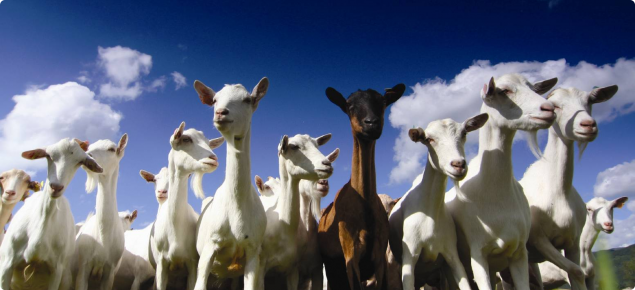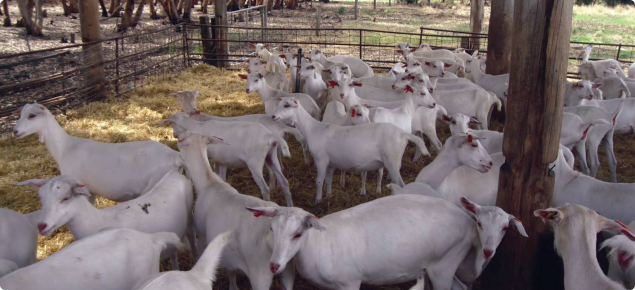Goat milk can provide an alternative for people who suffer with cow milk allergies and gastro-intestinal disorders.
But before you enter into such an enterprise you must ask yourself one vital question – will running dairy goats suit my lifestyle?
Although goats are very rewarding animals to work with, they will need to be milked twice a day for the majority of the year.
Breeds
In Australia there are six main dairy breeds (see Table 1).
Three are of Swiss origin – Saanen, Toggenburg and British Alpine, two have been recently bred in Australia – Australian Melaan and Australian Brown and one is from the Middle East – the Anglo Nubian.
| Breed | Appearance | Climate | Milk production | Fat yield | Temperament |
|---|---|---|---|---|---|
| Saanen | Short fine white/cream coat | Sensitive to excessive sunlight so performs best in cooler conditions | High level milk producer (better than the other breeds) | 2.5-3% | Very docile, responds quickly to affection |
| Toggenburg | Short fine coat that is deep chocolate to pale fawn with white points | Performs best in cooler conditions – least suited of the dairy breeds to tropical conditions | Medium –extended lactation periods | 3-4% | Very alert and extremely active. Responds well to training |
| British Alpine | Short fine glossy black coat with white points | Temperate climates, perform poorly in areas of high humidity | Medium to high milk producers | 3-4% | Very independent |
| Anglo Nubian | Can be any colour or combination | Best of the dairy breeds in Australia suited to hot conditions | Medium – considered dual purpose (dairy and meat) | Over 4% (typically used for cheese) | Responds very quickly to affection |
| Australian Melaan | Short fine glossy black coat | Are suited to both the sub tropics and the cooler conditions in the south of Australia | High level milk producer | 3-4% | Intelligent and placid |
| Australian Brown | All brown | Best suited to temperate climates and the cooler areas of Australia | High milk producer – long lactation period | 3-4% | Docile and easy to milk |
Management
Feed requirements
Good quality food and water is essential for good milk production. When determining feed rations, energy and protein are the most important elements to consider.
Lack of energy is the most common problem affecting production and protein is essential for growth, pregnancy and milk production. Feed analysis can be a valuable tool in determining what nutrients your feed may lack.
Fresh pasture is a great source of minerals, energy and protein and is a low cost source of feed. Rotational grazing can maximise the supply of pasture and minimise the need for supplementary feeding when pasture is in short supply.
Good grazing management is essential. Feed budgeting should be carried out throughout the year and take into account pasture supply and other sources of feed if needed. Surplus pasture can be harvested for future use by cutting for silage or hay.
Regular blood and tissue testing of goats is essential to ensure that copper (Cu), selenium (Se) and cobalt (Co) levels are adequate and that Cu and Se, which are toxic, are not over dosed.
A month before mating, the doe should be gaining weight so that they are in good condition when mated. It is vital that does are feed a diet that contains adequate energy and minerals, to help them meet the extra demands of the foetus and milk production.
A poor diet can lead to hypocalcaemia (milk fever – low levels of calcium in the blood) or pregnancy toxaemia (sleepy sickness – glucose deficiency).
AgriFutures Australia (formerly RIRDC) provides information on feed budgeting, describing the change in nutritional requirements at different times of the year and different stages of production (search 'dairy goats').
Kids should receive colostrum soon after birth. Colostrum contains the necessary nutrients and antibodies to protect them from disease.
If this cannot be obtained from the doe, there are other sources available (e.g. other does within the herd, cow colostrum, etc.). Hay and pellets should also be available from a few days old. It is important not to overfeed them.
Breeding
It is essential that you plan for kidding. Most does come into season during autumn and winter and have an 18-21 day oestrus cycle. First mating usually occurs when the doe is around 19 months old, however they can be fertile from three months old so it is important that they are separated from buck kids early.
Breeding is very seasonal so out of season breeding can be difficult and costly requiring the use of hormones and light manipulation. The gestation period for goats is approximately five months.
Most does are mated during autumn so that kidding will occur in spring, when there is plenty of green feed available. A doe usually averages two kids per mating. Newborns should be protected from predators (e.g. dogs, foxes) and have plenty of shelter.


